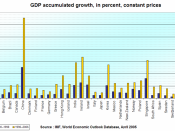China is everywhere these days. Powered by the world's most rapidly changing large economy, it is influencing our lives as consumers, employees and citizens. China's miracle economy, though largely initiated by Deng Xiaoping's market reforms in 1978, has resulted because of the current globalisation era in which barriers between nations have been reduced while economies have become increasingly converged leading to increased movement across nations of trade, investment, technology, finance, and labour.
By every measure, China's economy is growing rapidly. In 2003, China's GDP was $1.4 trillion. By that measure, China was the seventh-largest economy in the world. The economy of the United States is still by far the worlds biggest and with a 2003 GDP of $10.1 trillion it is seven times the size of China's. China's seventh-place ranking may be too low however, as the large underground economy and purchasing power parity are not taken into account.
Since China set about reforming its economy a generation ago, it has grown at an official rate of 9.5
percent. In Latin America, which is often seen as China's rival in low-cost manufacturing, economic progress over the last quarter of a century has been, on average, worse than it was in the region during the Great Depression. China has been able to grow at such a rate over these years because its economy has been heavily favoured by the globalisation process, particularly in the fact that the world keeps feeding it capital.
The Chinese government's responsiveness to the process of globalisation saw the implementation of a series of widespread structural reforms beginning in 1978. Foremost of these were the de-collectivisation of the agricultural sector and the implementation of the Special Economic Zones (SEZs).
China's movement from an agrarian based economy to a more manufacture-, services- oriented economy typifies the response of...



Well reserched and written essay
Not only it shows the impact on decline or growth about china is economy it goes deep to explain about the environmental factor and linked to other countries like Brazil. Keep up the good work.
3 out of 3 people found this comment useful.